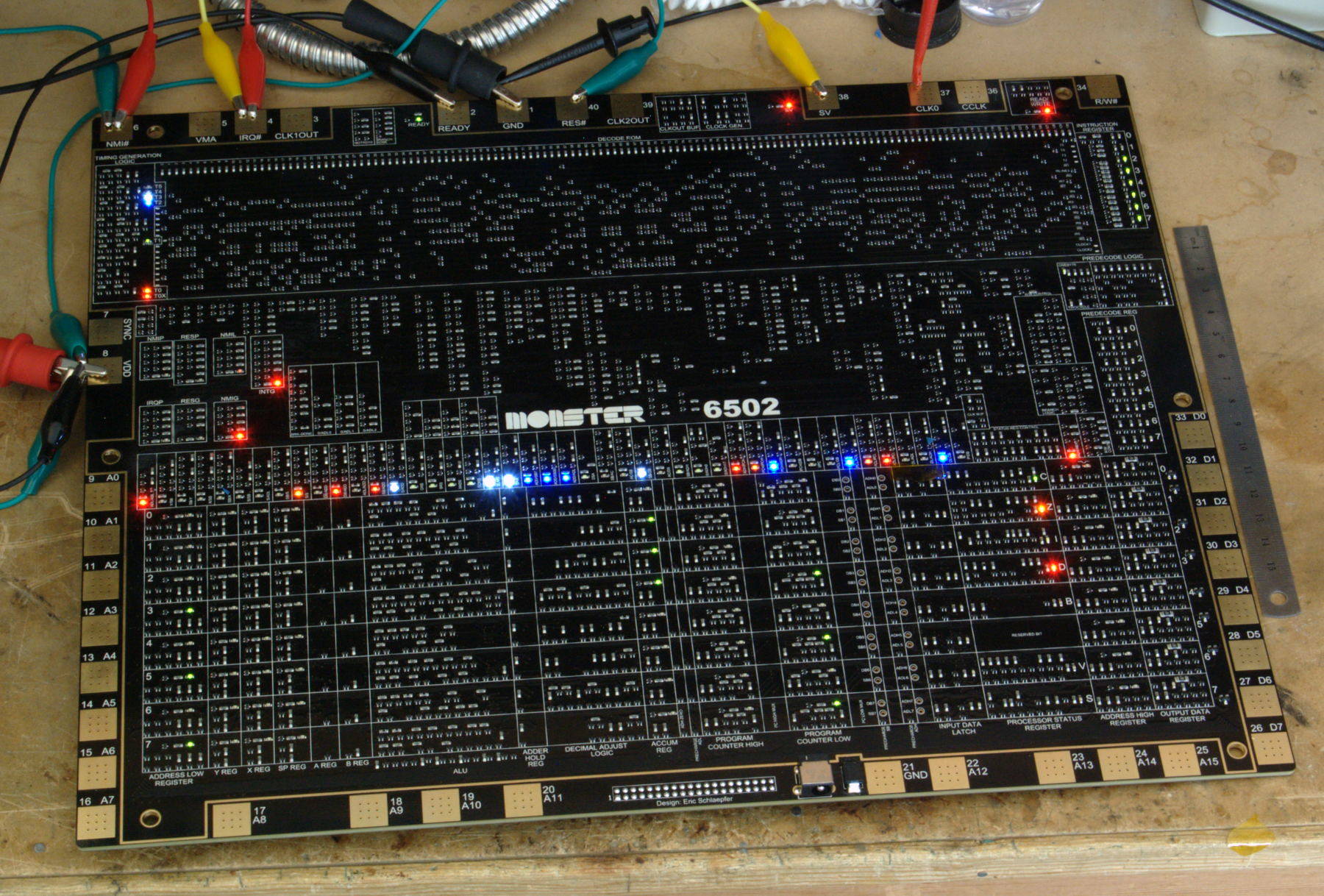
6502 Processor Large Scale
Resurrection Project
Ping!
The latest Apple/Mac/iOS Pings can be found by searching Keyword "ApplePingList" on FreeRepublic's Search.
If you want on or off the Mac Ping List, Freepmail me
Posted on 05/18/2016 10:21:45 AM PDT by dayglored
The 6502 CPU is a fondly-remembered CPU* for good reason: along with chips from Motorola, Intel and Zilog, it helped create the personal computer business in the 1980s.
However, this project is affection on a grand scale: some US enthusiasts are creating a transistor-for-transistor replica of the chip's design using discrete components.
It's a good thing we're in the era of surface mount components, because even with small components the 3,218 transistors, 1,019 resistors and various other bits of the MOnSter 6502 need a four-layer PCB measuring 12” x 15” with components mounted on both sides.
Because a big, slow, and mostly-useless processor board would be boring without flashing lights, it also includes 167 LEDs showing the values of “various control lines, registers, and status bits”.
Why do it? You could take a hint from the interests of one of the designers, Eric Schlaepfer, a vacuum tube enthusiast. He worked with Windell Oskay of Evil Mad Scientist Laboratories to design the MOnSter 6502.
Schlaepfer writes that other 6502 enthusiasts had already done the hardest work of reverse-engineering the innards of the chip:
“The hard work of reverse engineering the actual 6502 has already been done by the folks at Visual6502.org. I was able to extract the netlist from their Javascript simulation, which contains a list of all the transistors and every single wire connecting them together”.The enormous board – the name MOnSter 6502 is a play on the original MOS 6502 chip – will be on display at the 2016 Bay Area Maker Faire.
Regrettably, the chip won't be able to completely emulate the original 6502 inside an olde-worlde Apple board, because it's too slow.
The huge amount of capacitance on the board means its clock will probably max out between tens and hundreds of kilohertz. That might be enough, however, to get it to boot and run BASIC, Schlaepfer hopes.®
*Schlaepfer and Oskay like their disaggregated chips. They've also recreated discrete-component versions of two smaller classics: the 555 timer, and the 741 op-amp.
Woz and Jobs were originally going to use a chip in the 6800 family for their first project, even stenciled in the chip number, then the 6502 came out, more capability, better price. Besides the 8-bit Apple II (all were either 6502 or 65C02), the Commodore machines (prior to the Amiga) all used it (if memory serves), and the Atari 400 and 800, probably their home game machines as well used it. Nintendo used the last-gen 65816 in products prior to the Wii (which I believe uses PPC?).

The latest Apple/Mac/iOS Pings can be found by searching Keyword "ApplePingList" on FreeRepublic's Search.
If you want on or off the Mac Ping List, Freepmail me
Yeah, I had one of those. Stupidly threw it in the trash years and years ago.
If you wouldn’t call Commodore, Atari and Apple the vast majority of the personal computer/home computer market in the early 80s then I have to question where you are getting your numbers from.
C64 alone sold about 17 Million units, to this day it is still the number one selling PC of all time.. TI 99/4a was an interesting box, but they were out of the game by 83 it was discontinued, with a total sales volume of 2.8 Million units.
The Vic 20 sold 2.5 Million units over its life, and it too was a 6502 based machine.
Add the C128 which sold about 5 Million world wide, which was also a 6502 derivative, although it actually did ship with a z80 as well, for CPM mode, which was rarely used by owners.
Then you add up all the APPLE computers up to the IIGS (which was still a 65xx processor, but was a 8/16 instead of a pure 6502 8 bit architecture)... Plus the various models of the Atari PC’s and all the z80s spectrums and what not, don’t come remotely close to the volume of PC’s that were running 65xx cpus in the day.
By Volume the 65xx processor powered the overwhelming majority of personal computers in the home during this time frame... nothing else was even close in volume.
I sent away for information on the Altair 8800 from an ad in Popular Electronics, but never bought one (the benefit to cost ratio was way too low).
I eventually sold the brochures on eBay for some good money, though.
I had an H-89 and an H-90 that ran CP/M. I do miss it.
Where is the pictures of Bender? He has a 6502 in his head.

I had a Rockwell AIM-65. Learned assembly on it, then went to 68HC11, now using 9s12C32. Still using assemble. Can’t get into learning C. Made a few half hearted attempts.
I wasn’t counting the IIGS, I was stating that every apple II up until the IIGS was a 6502 8 bit... the IIGS was still a WDC 65XXX model, but it was the 8/16 chip. Don’t need to include it and stop with the purely 8 bit ERA...
The original MAC did show up in 84, (16 bit) and the ST and Amiga showed up in 86. But even if you combined all of there sales you don’t get anywhere near the sales of 6502 based machines.
So keeping the discussion to the 8 bit computers of the time, you really had some z80s... the 6502 and then some various custom chips. The TRS80 was z80 based and the original TRS 80 I only sold about 100k units.. PET’s were all 6502 Based. All the Apple II (with the exception of the GS) and the Applie III were 6502 based... All the Commodore and all the ATARI 8 bit machines were 6502 based. By sheer volume, no other processor comes remotely close in the early PC market.
You can add up all the Timex sinclaires, TI.994a’s, TRS 80 (and lets not forget that eventually even Radio Shack moved to from the TRS 80 to teh COCO which was 6502 based as well), Spetrums, osbones, coleco Adam’s, etc together and you don’t get anywhere near the number of machines that were in homes in that time based on the 6502. It was by far the basis of more home PC’s at the time than anything else in play.
Which was the first computer to sell over 1 Million units? The VIC 20.. 6502... what was second? The Apple II (6502) . Yes the 64 had a long shelf life, but most of those sales were not in the closing years of its production run. If you want to get into the consumer products such as video game systems the sheer number of 6502’s skyrockets even further, with 2600 and the NES both being 6502 based.
Yes there were other players in the market, and various custom chips, but the overwhelming majority of systems sold during those years were based upon 6502.
In the mid to late 70s you may have an argument that the z80 may have been king briefly, but it was ever so brief. By the 80s the 6502 had dominance in that space, and the fact the WDC is still manufacturing and selling a derivative of this chip to this day tells you how incredibly successful this chip is.
you may want to go here and check out the historical market share information.. http://www.360doc.com/content/12/0124/10/28217_181627497.shtml
by the 80.81 the 6502 based machines had the majority of the market,which they kept through most of the 80s, and in the later part of the 80s the IBM PC began to dominate sales, but for the early 80s, the 6502 based machine was the vast majority of the space.
What, no Sinclair ZX-80? My first was the ZX-81 in 1981. Great little learning toy.
I blew away the instructor by doing one project with four lines of code that everyone else needed 4 or 5 pages...and instructor for the class wrote custom OS’ for JPL
(It was a water flow sensor in just shifted a bit mask back an forth bases on a sample to trip some switches)
...when i put my mind to it a can write some incredibly elegant tight code ..but that cuz I get obsessive about it rewriting it and rewriting it to shrink it down....did some provisioning for a Cisco Nexus 7000 for American Express that had the senior Cisco CCIE on staff crazy to understand how the code worked.
Disclaimer: Opinions posted on Free Republic are those of the individual posters and do not necessarily represent the opinion of Free Republic or its management. All materials posted herein are protected by copyright law and the exemption for fair use of copyrighted works.